
When contacting us by e-mail, correspondents are asked to include their name and full postal address and, when providing information, to quote exact book and magazine sources. The word ‘chess’ needs to appear in the subject-line or in the message itself.
| 1 March
2005: C.N.s 3630-3631 4 March 2005: C.N.s 3632-3636 5 March 2005: C.N. 3637 6 March 2005: C.N.s 3638-3641 8 March 2005: C.N. 3642 9 March 2005: C.N.s 3643-3647 |
| First column | << previous | Archives [7] | next >> | Current column |
Jerry Spinrad (Nashville, TN, USA) sends the following report from page 12 of the New York Times, 14 November 1880:
‘Overpowered by Misfortunes
A Young Broker Shoots Himself – Interesting Family HistoryNicolai Gedalia, a native of Denmark, 23 years of age, committed suicide yesterday morning in his bedroom, at No. 349 East Fifty-eighth-street. He was a broker, dealing principally in mining stocks. He had an office at No. 70 Broadway, and was a member of the Mining Board. His father, who at one time was the leading financier of Denmark and the financial agent of the Rothschilds in Copenhagen, is at present in that city, but the rest of the family, consisting of the aged mother and an elder brother of the deceased, occupy a suite of rooms on the third floor of a “French flat” in Fifty-eighth-street, near First-avenue. Eighteen months ago Nicolai Gedalia began business as a stock broker in this City. He had been educated in the office of his father in Copenhagen, and he had, since his arrival in this country, been employed in the office of W.W. Hanly, at No. 60 Broadway. His anticipations were not realized. He lost money and soon became embarrassed. Two weeks ago 200 shares of stock, the losses on which he was unable to make good, were sold out under the rule of the Mining Board, in which he had a seat. His friends, however, came to his aid and a settlement was made with his creditors. He was still much discouraged, and as he subsequently met with other losses he determined to sell out his seat in the board and endeavor to obtain employment in some bank or broker’s office. He found it impossible to sell his seat to advantage, and this appears to have completely unnerved him. For a week he staid [sic] away from his office, and seemed moody and despondent. His mother and brother sat down to breakfast at about 8 o’clock yesterday morning, and sent the servant to summon Nicolai. While passing through the hall, she heard the report of a pistol. The brother of the deceased also heard the shot, and hurrying into his room found him lying dead on the floor, with a pistol-wound in his right temple. In his right hand he still clutched the pistol with which he had shot himself. His brother endeavored to maintain the theory that the shooting was accidental, but the facts as given above show conclusively that the unfortunate young man committed suicide. Coroner Hermann has charge of the case, and will hold an inquest.
The father of the suicide has a most remarkable history. He is a Hebrew, and now over 70 years of age. His parents were very poor. When a lad he was apprenticed to a saddler in Copenhagen, and for years worked as a journeyman saddler in the Danish capital. He had all the characteristics of his race. He was sober, frugal, and industrious, shrewd at making a bargain, and had an unconquerable ambition to rise above his humble sphere. For one of his race to obtain a commanding position in Denmark at that period was a task surrounded with almost insurmountable obstacles, but Gedalia persevered, and his ambition was after many years satisfied to its fullest extent. He started in business for himself as a saddler. Having accumulated some money by his business and speculations, he opened a small banking-house in Copenhagen. He speculated boldly and with great success, and became the financial agent of the Rothschilds in Denmark. He served the Austrian Government so well in several financial schemes that he received from it the title of Baron. He was also for years Consul-General of Portugal at Copenhagen, and received from the King of Portugal the decoration of the Order of Jesus. He was also decorated by the Danish Government, and was regarded as one of the greatest financiers of Europe. He met with reverses in 1875 and 1876, and the great wealth he had amassed began gradually to melt away. In this emergency he embarked in railroad speculations, which proved unsuccessful, and he became bankrupt. In 1877 he came to this City with his family, and endeavored to begin a new career. He did not succeed, and in the same year he returned to Denmark, where he now carries on a small banking business in Copenhagen.’
Which world champion wrote a book on a tournament in New York and one on a tournament in Moscow?
The illustration in C.N. 3621 showed page 72 of On The Objective Study of Crowd Behaviour by L.S. Penrose, our copy of which was dedicated to the biochemist N.W. Pirie, who assisted him with the book:

Although the inscription reads ‘December 1951’, the work was dated 1952.
Professor Penrose (1898-1972) was, it may be recalled, an eminent geneticist and, in the chess world, a respected player and problemist. He was the father of Jonathan Penrose, who was many times British chess champion.
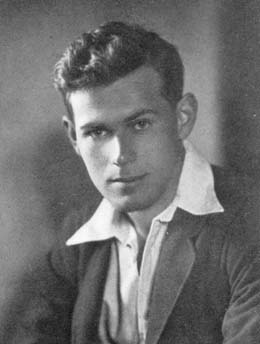
Lionel S. Penrose
Hubert Phillips ascribed the ‘How old is Mary?’ puzzle to Loyd, and that would seem proper; see, for instance, page 8 of More Mathematical Puzzles of Sam Loyd (New York, 1960). On the other hand, we note that the identical puzzle appeared on page 12 of the collection of H.E. Dudeney’s posers, A Puzzle-Mine by J. Travers (undated, but post-1930).
Like Loyd and Phillips, Henry Ernest Dudeney (1857-1930) was a chess devotee, and we begin here with one of his ingenious compositions:
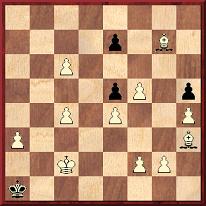
White mates moving only his bishops.
Mark N. Taylor (Mt Berry, GA, USA) reports that a catalogue by Kester Svendsen lists a short story entitled ‘The Mystery of the Missing Pawn: An Adventure of Herlock Shomes’ as having been published on pages 33-34 of the British Chess Bulletin, January 1911.
We should like to hear from any reader who can tell us more about the Bulletin, a very scarce publication. According to the entry in Douglas Betts’ Annotated Bibliography, it was ‘a monthly chess journal at a popular price’ edited by H.T. Dickinson and ran for four issues (October 1910 to January 1911).
The Karpov-Fischer photograph remains to be found, but Michael Clapham (Ipswich, England) has sent us a picture of a badge which appears to have been produced specifically for their expected match. He reports that it is 4cm high by 3.7cm wide and is made of metal and enamel.
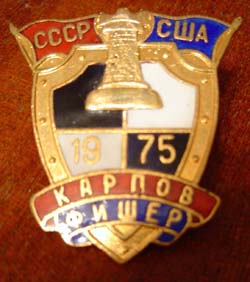
Previous items (e.g. C.N. 3451) have referred to the small photographs of chess personalities which frequently appeared at the top of pages of the Chess Amateur. The September 1910 issue (page 354) had the following:

This is evidently not Capablanca, but how did the mix-up occur?
Quite a list could be compiled of unkempt chess books by that odd but common type of writer, the would-be tutor with a well-camouflaged university education who, anxious to show that he is one of the lads even though chess is a bitter, fearsome pill, invigorates his lessons with rough colloquialisms, illiteracy, exclamation marks and other trappings of poverty. The opposite extreme is rarer in chess literature, for there are mercifully few books which are pretentious and pseudo-intellectual. Where chess does sustain such treatment it is liable to be at the hands of an outsider, such as V. Ulea, who, in 2002, somehow contrived to have the Southern Illinois University Press publish her 196-page book A Concept of Dramatic Genre and the Comedy of a New Type: Chess, Literature, and Film. The first words of the Preface (page xi) give fair warning of what is in store:
‘This book is an attempt to approach dramatic genre from the point of view of the degree of richness and strength of a character’s potential. My main goal is to establish a methodology for analyzing the potential from a multidimensional perspective, using systems thinking. The whole concept is an alternative to the Aristotelian plot-based (externally motivated) approach, and it is applied to an analysis of western and eastern European authors and also to contemporary American film.’
We nonetheless soldiered on, even after being informed on page 8:
‘To approach the problem of evaluation of the whole from the point of view of the general systems phenomenon, one must distinguish between the evaluation of an aggregate and that of a system when approaching a unity.’
At that early stage, still wishing to be a good sport, we were prepared to distinguish between anything V. Ulea wanted, provided that discussion of chess was imminent. Our reward came on page 14:
‘Now that the general concept of dramatic genre has been presented, let us discuss in detail the ways of measuring protagonists’ potential, using a multidimensional approach and a chess model.’
However, it was not until page 17 that her key point about ‘positional and combinational styles in chess and literature’ started to be chewed over:
‘The question of a character’s use of certain styles and methods in his or her decision making requires a special discussion, for it becomes crucial in understanding a character’s psychology and the degree of his or her limitations. Applying Katsenelinboigen’s terminology, which is borrowed from the game of chess, one may say that, in general, characters are divided into the two following types of players: positional and combinational.’
After a windy quote from Katsenelinboigen himself, V. Ulea resumed her elucidation:
‘In the combinational style, the player is not concerned with the creation of a predisposition for his future development since he is completely seized with the goal, which is a material objective. In the process, everything not linked to the capturing of the material objective is not considered by this type of player, and the question of what kind of predisposition will be created after the goal has been achieved is not of his concern. Unlike the combinational player, the positional player is occupied, first and foremost, with the elaboration of the position that will allow him to develop in the unknown future. In playing the positional style, the player must evaluate relational and material parameters as independent variables.’
Overleaf a further pounding awaited us:
‘According to Katsenelinboigen, the positional and combinational styles in chess signify two different approaches to overcoming obscurity. One approach represents the system from its end and is based on the creation of a program that links the initial step with the final goal. In so doing, the combinational player makes unconditional valuations of material parameters when it concerns the result, but he does not take into account positional parameters as independent variables. For instance, when the combinational chess player compares his sacrifices with the winning material, he applies unconditional values; at the same time, he does not pay attention to the position, for he is completely concerned with obtaining a concrete material. The combinational style can be interpreted as a degenerated case of the positional style, for in actuality the combination is only a part of the position, whether or not it is acknowledged by the player.’
Pausing only to wonder whether any writer would use the term ‘in actuality’ with a straight face, we pressed ahead, hoping for enlightenment in that chapter’s concluding ‘Summary’. Instead, page 26 offered this:
‘The creative process is distinguished by different stages; each stage consists of particular styles (positional and combinational), methods (reflexive and selective), and ways of connectivity (programming, predispositioning and randomness). In the process of creation, the artist combines all of these.
The combinational style is concerned with the creation of combinations that would allow one to obtain a material through setting a concrete goal and elaborating a program. The positional style is focused on the creation of a predisposition for future development, with combination as its stage.’
With that off her chest, V. Ulea accorded the game a well-earned rest in the wings, but it resumed centre-stage on page 85:
‘In the game of chess, relational (positional) parameters are not explicitly set, appearing during the game as a result of rules of interactions. The chess player creates relational parameters within a certain position and gives them valuations.’
Nobly resisting any temptation to turn such pages unread and thereby miss a nugget, on we plodded until finding that pages 144-145 discussed the relative value of the chess pieces in incomparable fashion:
‘The semiunconditional values of the pieces (such as queen 9, rook 5, bishop 3, knight 3, and pawn 1) appear as a result of the rules of interaction of a piece with the opponent’s king. All other conditions, such as starting conditions, final goal, and a program that links the initial condition to the final state, are not taken into account. The degree of conditionality is increased by applying preconditions, and the presence of all four preconditions fully forms conditional values.
Katsenelinboigen outlines two extreme cases of the spectrum of values – fully conditional and fully unconditional – and says that, in actuality, they are ineffectual in evaluating the material and so are sometimes replaced by semiconditional or semiunconditional valuations, which are distinguished by their differing degrees of conditionality. He defines fully conditional values as those based on complete and consistent linkages among all four preconditions. Accordingly, fully unconditional values are free of the preconditions; the introduction of the first preconditions, which is linked to the formation of the scale of positivity/negativity, results in the appearance of unconditional values. Semiconditional values are those based on some conditions, while semiunconditional values are formed by complete and consistent linkages between the rules of interactions, taking no other conditions into consideration.’
That second ‘in actuality’ somehow made our perseverance feel worthwhile, and a passage on the next page showed that the author, if no-one else, was unflagging:
‘The conditional evaluation of a character is based on his or her function in particular episodes. In chess, this analysis is described as “equivalently situation-specific valuations [that] incorporate all the constituent elements of a given position relative to the set goal” (Katsenelinboigen, Concept of Interdeterminism, 24).’
By now V. Ulea was running short of chessic insights, although there was, of course, no let-up in the verbiage. We nonetheless kept with her to the bitter end, valiantly casting aside worries about the conditionality and increasingly heavy positional parameters of our eyelids, as well as, in actuality, another equivalently situation-specific valuation of a semi-unconditional physical nature: our brain hurt.
Russell Miller (Chelan, WA, USA) points out that the 1880 census (made available at www.familysearch.org) gives details of the Gedalia family. ‘Nicholas’ was listed as being involved in the gold industry.
Apart from the two games in the New York, 1880 tournament mentioned in C.N. 3622 (and available in various databases), we have yet to find a good illustration of Gedalia’s play, although a draw and a loss appear in the American Chess Journal (February 1879, page 265, and June 1879, page 361).
From page 242 of Official Chess Handbook by K. Harkness (New York, 1967):
‘So far as the complaints of collusion among Soviet players are concerned, it is undoubtedly true that the Soviet contestants in FIDE tournaments, especially in the early competitions, have played as a team and not as individuals. Alexander Kotov admits this in his Memoirs of a Chessplayer, published in the USSR in 1960. He apologizes for his victories over Smyslov in 1933 [sic] and Botvinnik at Groningen in 1946, and hopes he will be forgiven, since he made up for these lapses by defeating Reshevsky and Euwe respectively in these tournaments.’
The reference to Smyslov evidently concerned the 1953 Candidates’ tournament, but can a reader send us the exact text (ideally in both Russian and English) of Kotov’s admission?
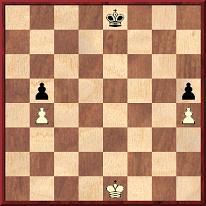
On pages 27-30 of Capablanca’s Last Lectures (New York, 1966), this position was discussed and the following two statements appeared:
‘When the kings face each other as in this example and the number of intervening squares is even, he whose turn it is to play has the opposition.’ (Page 28)‘When the kings face each other as in this example, and the number of intervening squares is odd, that player has the opposition whose turn it is to move.’ (Page 30)
(In the UK version of the book, published the following year, see pages 32 and 34 respectively.)
On page 397 of Chess Life & Review, June 1974 (the ‘Larry Evans on Chess’ column) a reader, J. McGinley, drew attention to the evident contradiction between the two statements, and Mr Evans remarked that ‘Capa’s statement on page 30 is wrong’ but that ‘this book was published after Capa’s death – he had no chance to check the manuscript’.
In fact, it seems a case of mistranslation. The introductory material to the book specifies that the lectures were written and broadcast in Spanish. The text was serialized in Ajedrez Español as from January 1943, and the above pawn ending was on pages 53-54 of the February 1943 issue. Capablanca’s wording for both statements was correct, and the second one read:
‘Cuando los reyes están de frente, como en este ejemplo, y el número de casillas intermedias es impar, tiene la oposición el que no juega.’
The Spanish word no was lost in the English translation.
Books inscribed by Capablanca in Spanish seem particularly scarce, and our collection contains only two: his Havana, 1913 book dedicated to the Marianao municipal library and a copy of A Primer of Chess inscribed to the Cuban player Evelio Bermúdez:
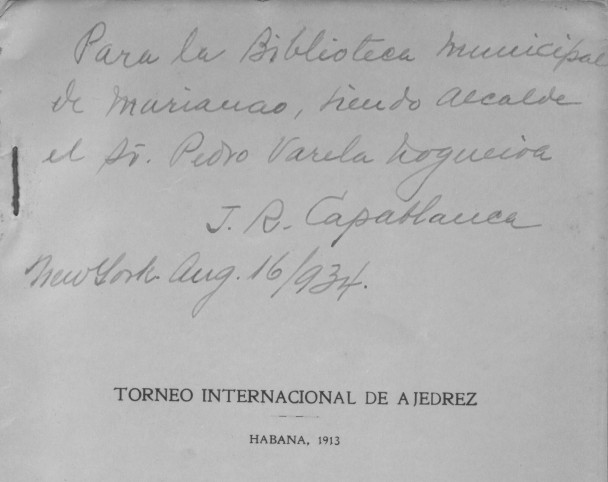
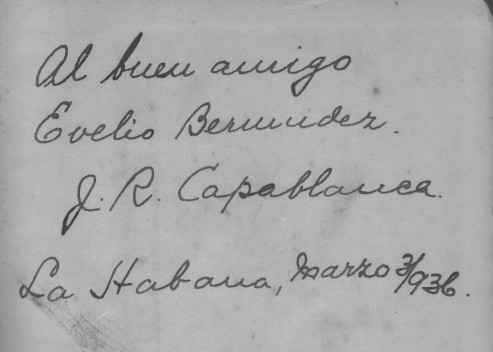
Any readers who are loath to tackle H.J.R. Murray’s 900-page A History of Chess (Oxford, 1913), or even to read his posthumous volume A Short History of Chess (Oxford, 1963, but written in 1917), may be interested and grateful to know that, a year before his death, he published an article on the origins of chess which was only 1,500 words long. It appeared on pages 88-90 of Things (London, 1954), a general reference book published by the Waverley Book Company Limited, and is reproduced below.
‘Chess is too well known to require a detailed description – enough to say that this greatest and most intellectually elegant of games of skill is played by two persons on a board of eight by eight “squares”, each player having 16 “men” – king, queen, two bishops, two knights, two rooks or castles and eight pawns, each type of man with its own powers of move and capture, the object of the game being to checkmate the adversary’s king – to force him, that is to say, into a position from which he cannot move without capture. Chess was invented in India, and before Indian chronology was put on a sound basis, exaggerated ideas as to the age of chess were formed and these are still often repeated.
It is in Indian and Persian works of the first half of the seventh century A.D. that chess is first mentioned; and of these works the oldest is the Karnamak, a Persian romance in which the hero is said to have excelled all his contemporaries at chess (chatrang). This was written about A.D. 600. Somewhat later chess is mentioned by Bāna, in his Sanskrit Harshacharita, in which he describes the peace and good order of Northern India under Sriharsha (A.D. 612-647), in a passage full of puns: “under this king only bees (shatpada) quarrel in collecting dews (dues), the only feet cut off are those in metre, only chess boards (ashtapada) teach the positions of the chaturanga (army or chess).” The ashtapada was a board of eight by eight squares which had reached India from Greece in the first millennium B.C., Greece and India having been in contact at least from the time of Alexander the Great.
The older Arab historians agree that chess was an Indian invention which reached Persia in the reign of Chosroes I (A.D. 531-579), and this is generally accepted as true. The invention of chess cannot be placed much earlier, for from A.D. 458 to 540 Northern India lay under the cruel domination of Hun hordes from Central Asia which “shook Indian society to its roots and severed the chain of tradition”. The invention of chess is accordingly dated about A.D. 560. This leaves rather a brief period for the adoption of chess in Persia, a difficulty that can be met by the facts that Chosroes aided in the destruction of the Huns, and that his interest in Indian culture led to his sending envoys to India to obtain a copy of the Fables of Pilpay. Later Arab historians ascribed the inception of chess to an Indian sage they called Sissa b. Dahir, borrowing the name which belonged to the first Indian prince with whom the Arabs came in contact. In fact the story is mythical.
That the inventor’s idea was to make a game of skill in which the operations of an Indian army could be illustrated is evident from the names which he gave to the game and its “men”. The complete Indian army from at least the fourth century B.C. contained four kinds of troops, infantry, cavalry, chariots and elephants, the aggregate being called a chaturanga, “composed of four elements”. In his game of chaturanga, the inventor added to these four elements the king and his minister or commanding officer; and he arranged his armies on the two opposite outer rows of the ashtapada, placing one army on the first and second and the other on the seventh and eighth rows; on the second and seventh rows he placed eight pawns, and on the first and eighth rows, starting from the corners of the board, he placed chariot, horse and elephant; on the two middle squares he placed king and minister, the two kings standing on the same file. He gave the king a move of one step in any direction, the minister one step diagonally; to the chariot he gave the move which the rook has in our modern chess, and to the horse the leap of the modern knight. The elephant leapt diagonally over one square to the square immediately beyond. The pawn took single steps forward on the file on which it stands, made captures on an adjacent square diagonally in advance, and was promoted to the rank of minister on reaching the end of the board. The aim of the game was either to checkmate the opponent’s king or to deprive him of all his men. Stalemate, which has no analogy in actual warfare, he gave as a win to the stalemated king.
The Persians only made two changes in the Indian game. They translated the names of the men and they made stalemate a draw. The Arabs when they conquered Persia, in A.D. 638-651, made no alteration in the Persian rules. Pre-Islamic Persia knew the game for less than a hundred years, but this brief period had an effect of great importance upon chess, since it gained a fixity of arrangement, a method of play, and a nomenclature which have attended the game everywhere in its western career.
Islam absorbed chess quickly and the names of many chessplayers before 750 have been preserved. Wherever Islam penetrated, so did chess, as far west as Spain, as far south as Zanzibar, as far east as the Malay Islands and as far north as Turkestan. But lawyers maintained that playing chess was against tradition and the Koran. The matter was only settled for the Sunnite sect by ash-Shafi‘i (d. 820), who was himself a chessplayer skilled in blindfold play, on the ground that chess was not only a game but a training in military tactics (it is part of the modern training of Russian army officers); he held that chess was lawful provided it was played with conventional men, was not played for money or in public, and did not interfere with the performance of religious duties. The Shiite sect omits the first condition. These rules never troubled the caliphs, who played freely and patronized good players, watching what we should call “championship contests”. Players were classified by their skill, and the names of the chess champions from 800 to 950 are known. Two of these, al-‘Adli and as-Sūli, wrote books on chess which are still quoted, and al-Lajlāj, a pupil of as-Sūli, enunciated the principles of play.
Christians on the Spanish Marches were playing chess soon after A.D. 1000, and it was played in Italy not much later. By 1100 it was played in Bavaria, France and England, and by 1250 it had reached Iceland. English and French players adopted the eastern names when they did not understand the meaning, and translated them when they did. Thus in England the minister became a “fers” (Arabic firzān, Persian Ferzēn, “wise man”, “counsellor”), the elephant an “alfin” (Arabic al-fīl, “the elephant”), and the chariot a “rook” (from the Persian rukh, for “chariot”). Our “checkmate” is from the Arabic shāh māta, “the king is helpless”, “Chess”, too, came into English in the Middle Ages and goes back through Arabic and Persian to the Sanskrit chaturanga. “Pawn” comes from a medieval French word for a foot-soldier. The Italians made chess a model of the European state, the minister becoming a queen and the elephant an elder who was often carved as a bishop. When the Lombards acquired the reputation of being the best European chessplayers, these changes of name were adopted in France and England. Chess became immensely popular, first in royal and knightly circles, then in towns and finally and more sparsely with the commonalty. By 1250 the earlier prejudice of the Church against chess was weakening, since the game was patronized by kings, and the monastic orders were gladly accepting chess as an alleviation of the monotony of convent life. By 1300 chess had acquired a literature of its own, had become the theme of poems, sermons and moralities, and was influencing the plot of romances. Chess had also become a regular feature in the education of royal and noble children.
Despite the general popularity of chess, there were signs that players were a little disappointed with it: a game took too long. Giraldus Cambrensis towards the end of the twelfth century noted that English players were dropping chess and turning to the solution of chess problems in which fewer men were used and which had a prescribed length. On the other hand, in Italy, the Lombard players were strengthening the moving power of some of the men, and by 1300 had given queen, pawn and king, in this order and for their first move only, an additional power. These attempts culminated in the great reform of the 1490s which gave queen and bishop their modern moves, making the study of Opening Play both possible and necessary, and revivified chess altogether. These changes led to the great chess activity of the period 1550-1640 in Italy and Spain, during which the reform was completed by the addition of “castling”, the combined move of king and rook. The reformed game was then adopted in Europe generally.’
The world champion who wrote books on tournaments held in both Moscow and New York was Max Euwe:
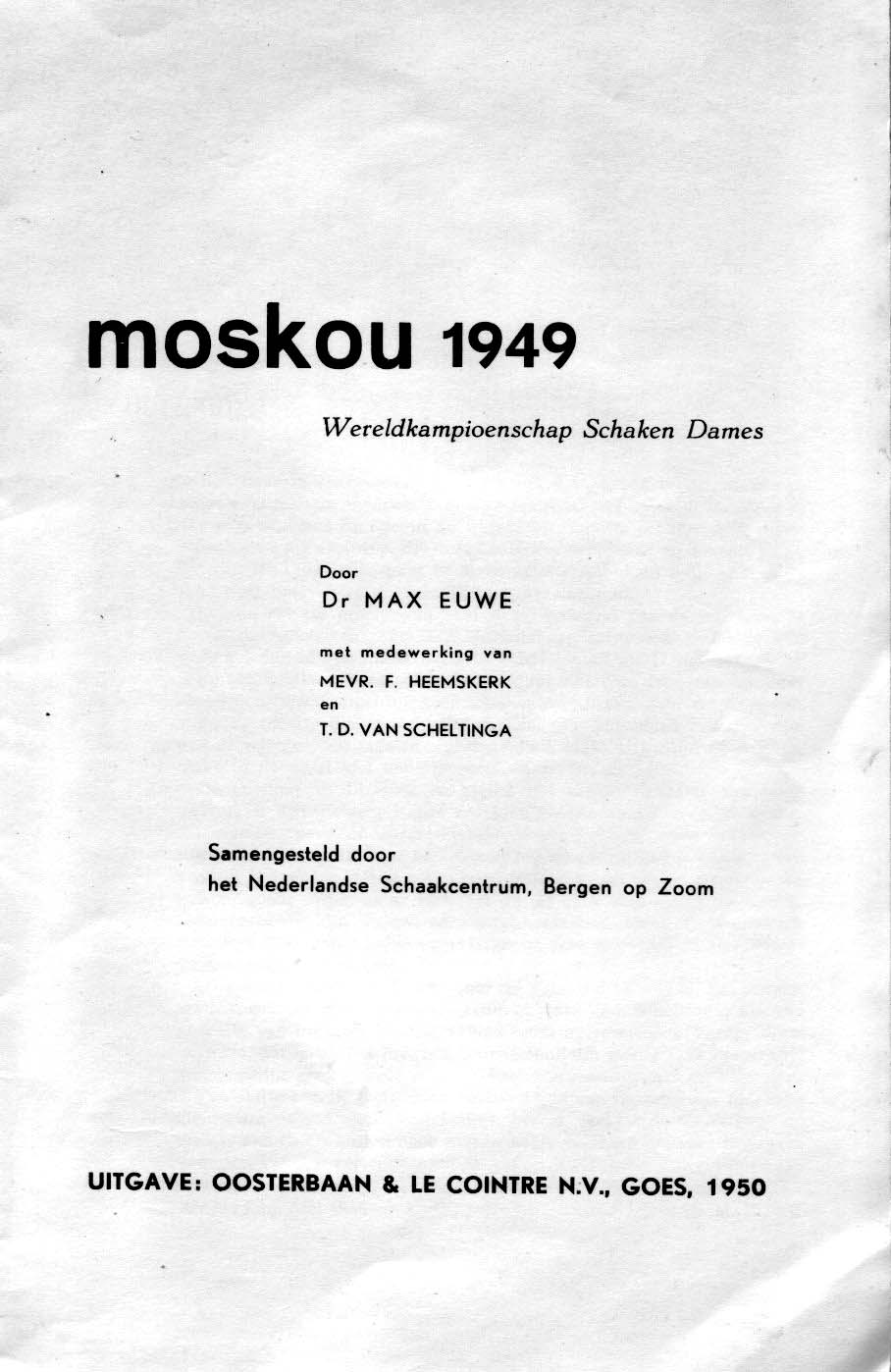
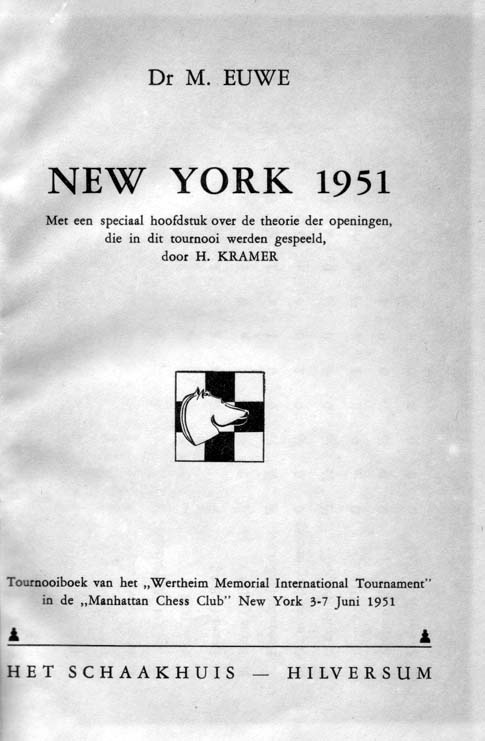
He also brought out a book on an event which was partly played in Moscow, Wereldkampioenschap Schaken 1948. Our copy is inscribed by the five participants:
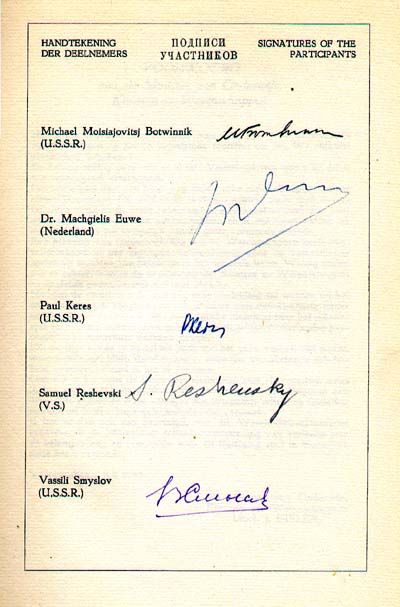
Following on from the reference to Henry Ernest Dudeney in C.N. 3633, here are six of his chess puzzles:
One:
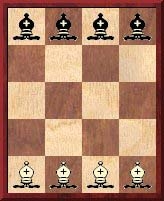
‘This is quite a fascinating little puzzle. Place eight bishops (four black and four white) on the reduced chessboard, as shown in the illustration. The problem is to make the black bishops change places with the white ones, no bishop ever attacking another of the opposite colour. They must move alternately – first a white, then a black, then a white, and so on. When you have succeeded in doing it at all, try to find the fewest possible moves.’
Two:

‘Here is a neat little puzzle in counting. In how many different ways may the two pawns advance to the eighth square? You may move them in any order you like to form a different sequence. For example, you may move the QRP (one or two squares) first, or the KRP first, or one pawn as far as you like before touching the other. Any sequence is permissible, only in this puzzle as soon as a pawn reaches the eighth square it is dead, and remains there unconverted. Can you count the number of different sequences? At first it will strike you as being very difficult, but I will show that it is really quite simple when properly attacked.’
Three:
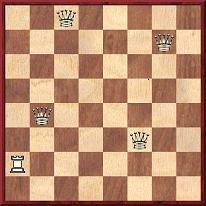
‘It will be seen that every square of the board is either occupied or attacked. The puzzle is to substitute a bishop for the rook on the same square, and then place the four queens on other squares so that every square shall again be either occupied or attacked.’
Four:
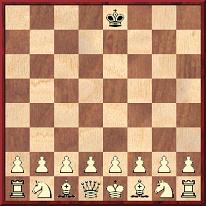
‘Set up the position shown in the diagram. Then the condition of the puzzle is – White to play and checkmate in six moves. Notwithstanding the complexities, I will show how the manner of play may be condensed into quite a few lines, merely stating that the first two moves of White cannot be varied.’
Five:
‘Starting from the ordinary arrangement of the pieces as for a game, what is the smallest possible number of moves necessary in order to arrive at the following position?

The moves for both sides must, of course, be played strictly in accordance with the rules of the game, though the result will necessarily be a very weird kind of chess.’
Six:
‘I have a single chessboard and a single set of chessmen. In how many different ways may the men be correctly set up for the beginning of a game? I find that most people slip at a particular point in making the calculation.’

H.E. Dudeney
From John Richards (Bristol, England):
‘In C.N. 3554 you reproduced a photograph of the participants in Spa, 1926. One of the actual participants, Emanuel Sapira, who finished third on 8/11, is not shown, but I. Censer, who did not take part, appears instead. Do you know if Sapira was a late substitute, or is it really Sapira in the photograph?’
Sapira was absent from the photograph (which was published as a supplement to the September 1926 issue of L’Echiquier). The person between Soultanbéieff and Koltanowski was indeed Censer, whom the Belgian magazine described as the ‘directeur des Tournois’. A portrait of him, with other players from Belgium, appeared on page 33 of Chess Pie, 1927:
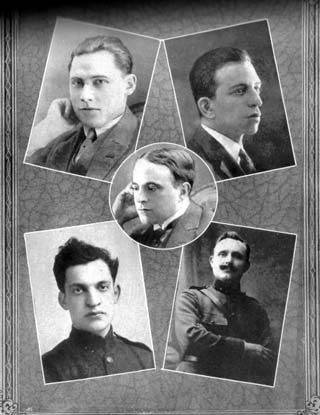
I. Censer is in the top right-hand corner. Then, clockwise, come M. Lenglez, G. Koltanowski and A. Louviau, with M. Wilden in the centre.
Mr Richards also draws our attention to an article he has written on Mary Rudge: www.johnrichards.pwp.blueyonder.co.uk/horfield/MaryRudge.pdf
We have acquired a promotional leaflet (no year indicated) for one of Birdie Reeve’s exhibitions. It includes a photograph of her ostensibly giving a simultaneous display:
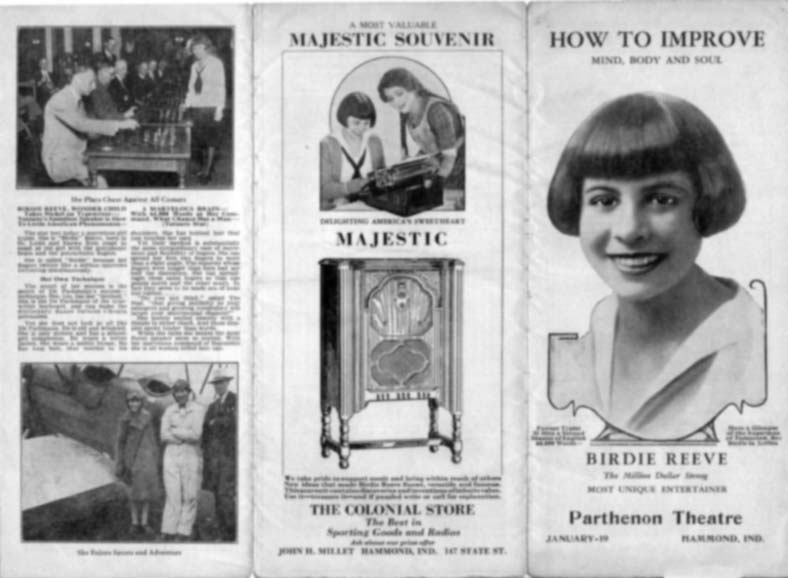

Larger versions of side one and side two of the leaflet are provided for perusal.
Jerry Spinrad (Nashville, TN, USA) has now discovered that Birdie Reeve died of a heart attack on 31 May 1996 at the age of 89, and that her obituary was published on page 53 of the Chicago Sun Times, 3 June 1996. The newspaper referred to ‘her ability to type 200 words a minute with just two fingers on each hand, spread out in a V formation’ and noted that George Burns mentioned her ‘great act’ in his autobiography All My Best Friends. The obituary also stated that ‘her vaudeville career ended in 1931 with the birth of her daughter, Hope Hirschman of Lincolnwood’. There was no mention of chess.
Chess Notes Archives:
| First column | << previous | Archives [7] | next >> | Current column |
Copyright 2005 Edward Winter. All rights reserved.